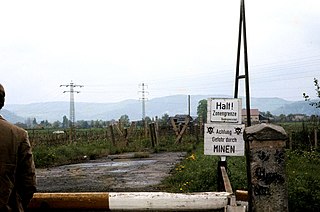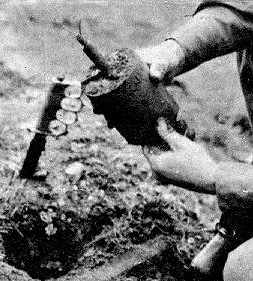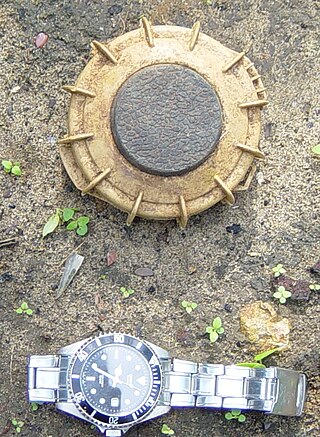
A land mine, or landmine, is an explosive weapon concealed under or camouflaged on the ground, and designed to destroy or disable enemy targets, ranging from combatants to vehicles and tanks, as they pass over or near it.

The Claymore mine is a directional anti-personnel mine developed for the United States Armed Forces. Its inventor, Norman MacLeod, named the mine after a large medieval Scottish sword. Unlike a conventional land mine, the Claymore may be command-detonated, and is directional, shooting a wide pattern of metal balls into a kill zone. The Claymore can also be activated by a booby-trap tripwire firing system for use in area denial operations.
The GATOR mine system is a United States military system of air-dropped anti-tank and anti-personnel mines developed in the 1980s to be compatible with existing cluster dispensers. It is used with two dispenser systems—the Navy 230 kg (500 lb) CBU-78/B and the Air Force 450 kg (1,000 lb) CBU-89/B. Additionally the mines are used with the land- and helicopter-based Volcano mine system.

A combat engineer is a type of soldier who performs military engineering tasks in support of land forces combat operations. Combat engineers perform a variety of military engineering, tunnel and mine warfare tasks, as well as construction and demolition duties in and out of combat zones.
A Bangalore torpedo is an explosive charge placed within one or several connected tubes. It is used by combat engineers to clear obstacles that would otherwise require them to approach directly, possibly under fire. It is sometimes colloquially referred to as a "Bangalore mine", "banger" or simply "Bangalore" as well as a pole charge.

An anti-personnel weapon is a weapon primarily used to maim or kill infantry and other personnel not behind armor, as opposed to attacking structures or vehicles, or hunting game. The development of defensive fortification and combat vehicles gave rise to weapons designed specifically to attack them, and thus a need to distinguish between those systems and ones intended to attack people. For instance, an anti-personnel landmine will explode into small and sharp splinters that tear flesh but have little effect on metal surfaces, while anti-tank mines have considerably different design, using much more explosive power to effect damage to armored fighting vehicles, or use explosively formed penetrators to punch through armor plating.

In the military science of fortification, wire obstacles are defensive obstacles made from barbed wire, barbed tape or concertina wire. They are designed to disrupt, delay and generally slow down an attacking enemy. During the time that the attackers are slowed by the wire obstacle they are easy to target with machine gun and artillery fire. Depending on the requirements and available resources, wire obstacles may range from a simple barbed wire fence in front of a defensive position, to elaborate patterns of fences, concertinas, "dragon's teeth" and minefields hundreds of metres thick.

The Mk 153 Shoulder-Launched Multipurpose Assault Weapon (SMAW) is a smoothbore shoulder-fired rocket launcher. It is a portable assault weapon and has a secondary anti-armor ability. Developed from the B-300, it was introduced to the United States Armed Forces in 1984. It has a maximum effective range of 500 metres (550 yd) against a tank-sized target.

An area denial weapon is a defensive device used to prevent an adversary from occupying or traversing an area of land, sea or air. The specific method may not be totally effective in preventing passage, but is sufficient to severely restrict, slow down, or endanger the opponent. Some area denial weapons pose risks to civilians entering the area even long after combat has ended, and consequently are often controversial. An area denial weapon can be part of an anti-access/area denial (A2/AD) strategy.

The M728 Combat Engineer Vehicle (CEV) is a full-tracked vehicle used for breaching, obstacle removal, and pioneering operations. Production commenced in 1965 and ceased in 1987. A total of 312 of all variants of these armored engineer vehicles were produced.

In anti-tank warfare, an anti-tank mine is a type of land mine designed to damage or destroy vehicles including tanks and armored fighting vehicles.

The German S-mine, also known as the "Bouncing Betty" on the Western Front and "frog-mine" on the Eastern Front, is the best-known version of a class of mines known as bounding mines. When triggered, these mines are launched into the air and then detonated at about one metre (3 ft) from the ground. The explosion projects a lethal spray of shrapnel in all directions. The S-mine was an anti-personnel mine developed by Germany in the 1930s and used extensively by German forces during World War II. It was designed to be used in open areas against unshielded infantry. Two versions were produced, designated by the year of their first production: the SMi-35 and SMi-44. There are only minor differences between the two models.

Demining or mine clearance is the process of removing land mines from an area. In military operations, the object is to rapidly clear a path through a minefield, and this is often done with devices such as mine plows and blast waves. By contrast, the goal of humanitarian demining is to remove all of the landmines to a given depth and make the land safe for human use. Specially trained dogs are also used to narrow down the search and verify that an area is cleared. Mechanical devices such as flails and excavators are sometimes used to clear mines.
The Giant Viper was a trailer-mounted, vehicle-pulled, mine clearance system, designed to be deployed in areas containing land mines. It was developed for the British Army in the 1950s. It was designed to be towed behind a Centurion gun tank, FV4003, AVRE ; and also the FV432 Armoured personnel carrier.

The M16 mine is a United States-made bounding anti-personnel mine. It was based on captured plans of the World War II era German S-mine and has similar performance. The mine consists of a cast iron body in a thin steel sleeve. A central fuze well on the top of the mine is normally fitted with a pronged M605 pressure/tension (tripwire) fuze. Sufficient pressure on the prongs or tension on an attached tripwire causes the release of a striker. The freed striker is forced into a percussion cap which ignites a short pyrotechnic delay. The purpose of this delay is to allow the victim to move off the top of the mine, to prevent its upward movement from being blocked. Once the delay has burned through, a 4.5-gram black powder charge is ignited, which launches the inner iron body of the mine up into the air. The charge also ignites a second pair of pyrotechnic delays.

An anti-personnel mine or anti-personnel landmine (APL) is a form of mine designed for use against humans, as opposed to an anti-tank mine, which target vehicles. APLs are classified into: blast mines and fragmentation mines; the latter may or may not be a bounding mine.

A mine-clearing line charge is a device used to create a breach in minefields under combat conditions. While there are many types, the basic design is for many explosive charges connected on a line to be projected onto the minefield and then exploded, detonating any buried mines, thus clearing a path for troops to cross.
Barrage is a military term covering a wide range of structures, devices, or measures for destroying something to constrain or impede the movement of troops and forces.
Rafael Carpet is a mine breaching system developed by Rafael Advanced Defense Systems, an Israeli weapon development company. First introduced in 2006, it has been adopted by the Israel Defense Forces and was scheduled to be fielded with the French Army by 2007. The system employs a unique implementation of fuel-air explosive (FAE) technology, offering an efficient and safe method for clearing minefields and neutralizing IEDs.
















